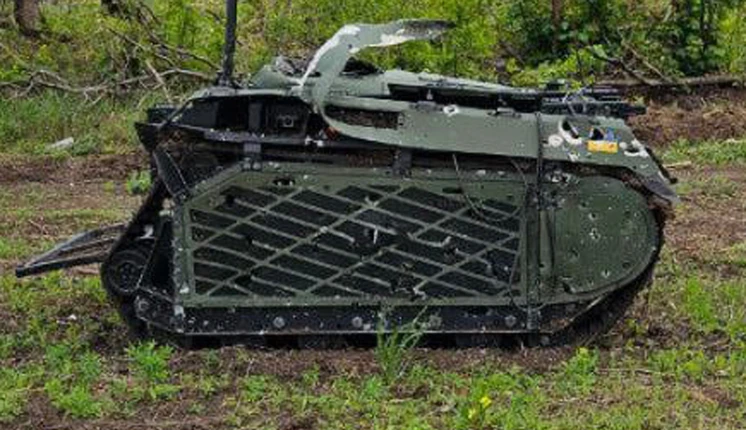Recently, a photo of an unusual trophy that ended up in the hands of Russian fighters appeared on social networks. It is the Estonian unmanned ground platform Tracked Hybrid Modular Infantry System (THeMIS). This equipment is considered the most advanced in the West and has already been ordered by 16 NATO countries, including France, Germany, Britain, and the USA.
Studying the first Estonian combat robot, THeMIS, captured as a trophy in the special military operation zone by Russian designers, can provide a lot of useful information and help in creating Russian analogs, said Ruslan Pukhov, the head of the Center for Analysis of Strategies and Technologies (CAST), a member of the Public Council under the Ministry of Defense of the Russian Federation.
CAST previously announced that it was ready to pay Russian military personnel a reward of two million rubles for capturing a THeMIS.
Estonia delivered the first robots to Ukraine in 2022. However, until now, this equipment has not fallen into Russian hands. TheMIS are mainly used for evacuating the wounded from the front lines and delivering ammunition.
The value of the tracked vehicle lies, in particular, in the fact that it is equipped with cameras that allow checking dangerous areas without putting soldiers at risk.
Ruslan Pukhov explained the value of the trophy to the Russian newspaper MK, “We will determine the military-technical value of the trophy when specialists look inside this robotic platform. A significant value lies in the software, but it is highly unlikely that we will be able to access it. However, it would be extremely useful to examine the design and engineering solutions in terms of electrical engineering and mechanics.”
According to Ruslan, “We really hope that the robot is not too damaged.”
He added, “The photo shows that the device is almost riddled with holes, and it is quite possible that the value of the trophy for study by our designers and engineers is significantly reduced. Next week, we will begin consultations with the Ministry of Defense to learn about the robot’s condition and also to find out exactly which military personnel captured this specimen so that they can receive the promised reward.

Pukhov reported that he had seen information about the trophy on social media.
“Now we need to obtain official information from the military department, which we will start doing on Monday. We need to make sure that the robot was indeed captured as a trophy and that it is in a condition that can be useful for study,” he said.
According to him, the interest in this type of robot is due to the recent attention paid to unmanned aerial and naval technology in our country. In contrast, ground combat robots have received much less attention.
“In this area,” Pukhov says, “there is a critical lag, and we really want to help overcome it. Estonia has several breakthrough developments; they are seriously investing in the weapons of the future, cyber technologies, and robotics. Therefore, it makes sense to study all this in the trophy so as not to reinvent the wheel.”
THeMIS unmanned ground vehicle
Milrem Robotics, headquartered in Estonia, manufactures the THeMIS unmanned ground vehicle (UGV). THeMIS is a tracked unmanned vehicle measuring 3.75 feet in height and 7.8 feet in length. Logistics, combat, intelligence, surveillance, and reconnaissance (ISR) or explosive ordnance disposal (EOD) are all viable configurations for the system. The UGV has a payload capacity of 750 kilograms. Hence, the capability to accommodate diverse cargo is contingent upon the requirements of the operation or the unit. It can be employed for various purposes such as transporting regular cargo, mortar operations, CASEVAC missions, facilitating rapid evacuation, and engaging in combat. Among the payload options are loitering munitions, counter unmanned aerial system (UAS) systems, cannons, and javelin missiles.
It is an exceptionally sophisticated UGV outfitted with various technical functionalities designed to facilitate military undertakings. Advanced sensors and cameras enable it to navigate difficult terrain and perform tasks with high autonomy. It has a maximum speed of 20 kilometers per hour and a maximum payload capacity of 1,250 kilograms. Combining an internal combustion engine and an electric motor, its hybrid-electric drive system enables it to travel for up to 15 hours on a single tank of fuel. In addition to being built from reinforced steel and aluminum, THeMIS is designed to be extremely rugged and resilient, withstanding difficult terrain and extreme weather.
The efficacy of the THeMIS UGV has been demonstrated through many exercises and experiments, as well as the Operation Barkhane mission executed in Mali. The principal objective of this UGV is to minimize the requirement for personnel on the battlefield through its multifunctionality, which encompasses transportation, ordnance disposal, intelligence operations, and weaponization. The open architecture of THeMIS facilitates rapid configuration for various missions.
